Have you ever tried explaining thunder to a curious six-year-old?
You could say, “It’s just sound waves from lightning.” Or… you could say, “It’s the sound of cloud giants bowling in the sky.”
Guess which one they’ll remember?
That’s the magic of mythology. It takes ordinary questions and gives extraordinary answers. Short mythology stories for kids aren’t just entertaining.
They’re how kids start to explore meaning, imagination, and wonder. In a world of scrolling and screens, these stories slow things down and open up space for dreaming.
I’m not here to pitch a bunch of fairy tales dressed in academic robes. I’m talking about raw, ancient stories.
Shaped by firelight and passed down through mouths, not machines. The ones that still hit, even centuries later.
Short Mythology Stories for Kids
Discover magical stories about gods, heroes, and creatures that come to life! Perfect for kids who love adventure and fun. Ready to explore amazing myths in just a few minutes? Let’s start the adventure!
The Sky Blanket

Origin: Inspired by Inuit and Native Arctic myths
Moral: Every small act matters
The Endless Night
Long ago, before stars blinked in the sky and before the moon found her silver smile, the world above was nothing but ink — dark, cold, and heavy. The sky had no face, no shimmer, no end. Just blackness.
In a small snow-covered village near the edge of the world, a seal pup named Suka blinked up at the nothingness above. “Why is the sky so empty?” she asked her mother one night.
Her mother gave her a warm nose nudge. “That’s just how it’s always been, little one. We have snow. We have fire. And we have stories.”
But Suka wasn’t satisfied with that answer. Something inside her — a flicker, a whisper, a tiny pull — told her the sky wanted more.
A Question That Wouldn’t Go Away
Each night, Suka curled into her bed of moss and fur but couldn’t stop wondering. She watched the other young animals — the fox kits, the snowy owls, the wolf pups — and noticed how they all glanced up and quickly looked away.
They didn’t like the darkness either.
One morning, while the village still slept, Suka climbed the snowy hill behind her home and looked out at the ice fields. The silence was so big, it felt like even the mountains were holding their breath.
She whispered into the stillness: “What if the sky isn’t finished yet?”
That question sat with her all day, nipping at her like the wind on her whiskers.
The Dream That Sparked It All
That night, Suka had a dream.
She saw a giant loom in the sky, made of ice and bone. A weaver made entirely of wind was trying to thread it, but nothing stuck. Every color it tried slipped away, leaving only blackness behind.
Then, a small paw — her own — reached out and tossed a snowflake upward. It landed softly and stayed.
The weaver paused. Looked at her. Smiled.
Suka woke with a jolt. Her heart pounded. “It’s snow,” she whispered. “That’s how I begin.”
The First Snowflake
The next day, Suka began her mission. She scooped a pawful of fresh snow, shaped it with care, and waited until twilight.
When the first stars should have come — but never did — she threw her snowflake into the sky.
Nothing happened.
The wind blew. The dark loomed. And Suka sighed.
But then… she looked again. Was that a shimmer? A flicker? A pinprick of silver, too small for anyone else to see?
It was enough.
The Laughter of Doubters
Word spread quickly.
“Suka is throwing snow at the sky,” snorted a grumpy old walrus.
“What’s next — teaching fish to knit mittens?” chuckled a puffin.
Even the polar bears rolled their eyes.
But Suka didn’t stop. Every night, she packed new snowflakes — some shaped like hearts, some like paws, some just soft and round — and tossed them with all her strength.
And the sky?
It began to listen.
The Village Begins to Notice
A week passed. Then two.
One evening, as the sun dipped away, the smallest wolf pup yelped. “Look!” he cried. “Up there! Tiny dots!”
The elders squinted. They saw them too — faint, scattered glimmers high above. Too random to be snow. Too steady to be wind tricks.
“What are they?”
“Why are they… beautiful?”
Only Suka smiled and stayed quiet.
When the Animals Joined In
It happened slowly.
First came Lani the owl, who added feathers to the snow before tossing them into the sky.
“Maybe it will help them float longer,” she said.
Then Niko the young narwhal launched icy droplets with his horn from the bay.
Soon, even the grumbling walrus helped. He slapped snow into large clumps and boomed, “Let the sky chew on this!”
And every night, the sky grew brighter.
The Blanket is Born
The stars began to connect.
The shimmer turned to sparkle. The dots formed trails and clusters, pictures and paths. Some looked like dancing seals. Others like running bears or flying birds.
The elders finally gathered the children. “We have something to say,” they announced. “We were wrong. The sky was not finished. Suka helped finish it.”
The pups and cubs and chicks squealed with joy. They named it The Sky Blanket — a gift from the ground to the heavens.
The Final Gift
One night, as the village celebrated under a sky of a thousand stars, the wind returned.
It danced around Suka and lifted her slightly into the air. Just a few inches, like a bow. She giggled.
“You saw what no one else saw,” the wind whispered in her ear. “So now, when pups are born with wonder in their eyes, your name will be the first story they hear.”
Suka glowed. Not from the outside — but from deep, deep inside.
The Story That Never Ends
To this day, in snow-covered villages near the edge of the world, seal pups still hear the tale of the sky that had no stars — and the little one who dared to change that.
Whenever a child asks why the stars look like tiny flakes or scattered paw prints, the answer is simple:
“Because a seal named Suka wanted the sky to feel loved.”
And each night, as snow falls gently and quietly to earth, it’s said the stars fall too — just a little — to thank the ones who helped them rise.
Tara and the Mountain’s Tear
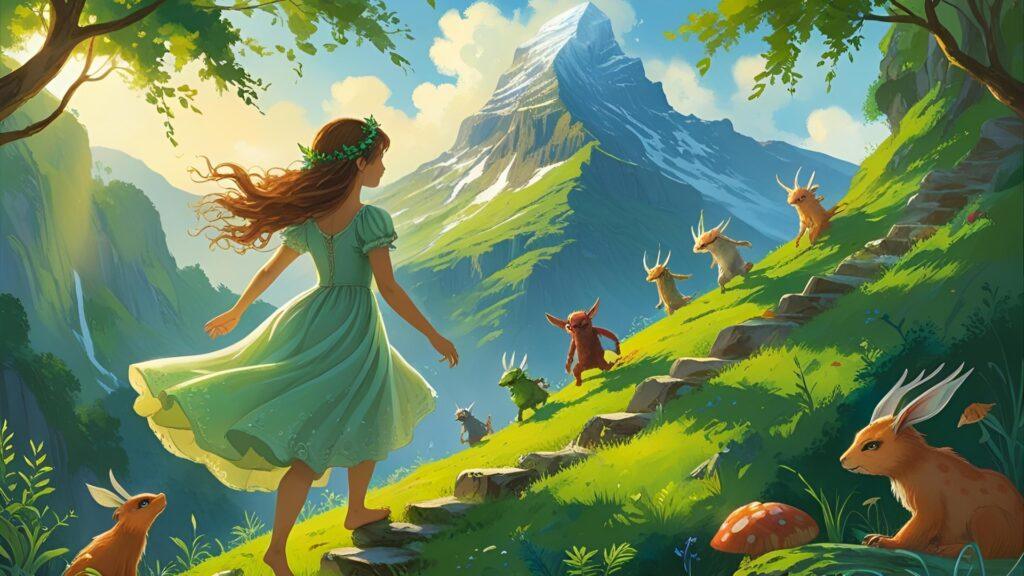
Origin: Inspired by Himalayan legends
Moral: True strength comes from compassion
The Girl Who Talked to Mountains
High in a village tucked between the clouds and peaks, there lived a girl named Tara. She was small for her age but walked like someone with purpose — chin up, feet sure.
Tara had no siblings, so she spent most of her time wandering the slopes, whispering to trees, chasing shadows, and talking to the mountains.
“Good morning, Old Grey,” she’d say to the tallest peak.
“Don’t be shy,” she’d tease when mists rolled in.
Sometimes, she thought she saw the mountain nod back. Or smile.
The grown-ups in the village often said, “Tara’s head is in the clouds.”
But Tara didn’t mind. That’s exactly where she wanted it to be.
The Drought That Changed Everything
One summer, the rains stopped.
At first, no one worried. Rain was shy in the highlands. It always came late — but it always came.
But this time, it didn’t.
The crops turned brittle. The river shrank. Even the wind felt dry and tired. The village well dropped lower and lower until people whispered of empty buckets and cracked lips.
And then, one night, someone said it aloud:
“It’s the mountain’s fault. Old Grey is angry.”
People muttered. Nodded. Looked up at the giant peak with suspicion.
A Blame That Grew
Old tales were dug out like dusty blankets.
“Long ago, the mountain swallowed a temple,” said an elder.
“Maybe we built too high,” said another.
“The gods are punishing us,” someone whispered.
They stacked stones, lit incense, sang forgotten prayers. But still, no rain.
Some even said, “We should not look at the mountain. It’s cursed.”
So they stopped.
But Tara couldn’t.
Each evening, she climbed her favorite slope and looked up at Old Grey. He didn’t seem angry. Just… quiet. Sad, even.
The Climb
One morning before dawn, Tara packed a satchel with roasted barley, a flask of goat milk, and her red scarf. She left a note on her sleeping mother’s pillow:
I’m going to talk to him. Don’t worry. Love, Tara.
And with that, she began to climb.
The path was steep, stitched with roots and ice. She slipped, scrambled, and sometimes crawled. But she kept going — up through clouds, past fluttering prayer flags, past things with claws that watched but didn’t stop her.
The wind howled. “Go home.”
The stones crumbled. “Turn back.”
But her heart whispered, “Keep going.”
The Eye of the Mountain
By evening, she reached a wide ledge. A stillness hung in the air — too still, too deep.
Then she saw it: an opening in the rock, shaped like an eye. Not carved. Not natural. Just… there.
She stepped inside. Cool air brushed her skin like silk. The cave pulsed, not with light, but with presence. Something was awake. Watching. Breathing.
She whispered, “I know you’re not angry. But why are you sad?”
The walls didn’t echo. The cave didn’t answer. But Tara waited. She sat cross-legged, placed her hand on the ground, and closed her eyes.
The Tear
Hours passed.
Then — a drop. On her palm. Warm.
She opened her eyes. Water was trickling down the cave wall — not from a crack, but from the stone itself. Like a tear.
And then came the voice. Not out loud. Not inside her head. But everywhere at once. Deep, slow, gentle.
“I am old,” it said. “I have carried snow, wind, fire. I have held temples, buried cities, listened to songs no one sings anymore.”
“Why are you crying?” Tara asked.
“Because no one listens,” the mountain said. “They only ask. They only blame.”
The Song She Sang
Tara swallowed. Then, softly, she began to hum.
A song her grandmother used to sing. A lullaby of rivers and roots. A melody shaped like home.
She sang it all — even the parts she barely remembered. Her voice cracked. But she didn’t stop.
And something changed. The cave warmed. The ground beneath her pulsed like a heartbeat. The water from the wall began to flow faster — not tears, now, but something older. Something freer.
The Gift
The mountain spoke again.
“Thank you, little singer.”
And then — Tara saw it. A ribbon of water snaking down the stone, out the cave, down the cliffs, toward the valley. A spring. Clear, endless, alive.
“Take this home,” the mountain said. “Not because they deserve it. But because they need it.”
The Return
Tara ran. Down the trail, past startled birds and glowing moss. She followed the spring, watching it braid through rocks, gathering speed, heading straight for the village.
By morning, the river had returned. The well filled. The goats danced. The people cheered.
Someone said, “The mountain has forgiven us.”
Someone else whispered, “We should thank Tara.”
But when they looked for her, she was already climbing again. Just to say thank you back.
The Lesson of Listening
From that day on, the village changed.
Children learned to sing to the hills. Farmers listened to the wind before planting. And elders told the story of a girl who climbed a grieving mountain not with anger, but with a question — and a song.
They say the spring still runs from Old Grey’s eye, and on clear nights, if you sit very still, you can hear the mountain hum back the tune Tara sang.
Not because he was sad anymore.
But because he remembered being heard.
Kiran and the Whispering Tree
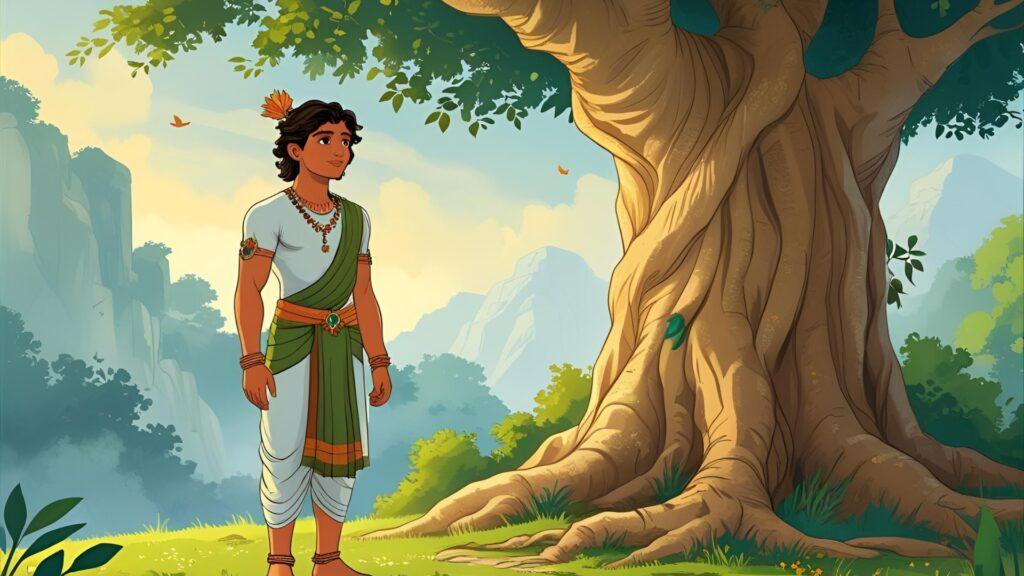
Origin: Inspired by Indian forest folklore
Moral: Listen before you act
The Loudest Girl in the Village
Kiran was the kind of child you heard before you saw.
“Watch me!” she’d yell before jumping into the river.
“Race you to the mango tree!” she’d shout, even if no one agreed to race.
She didn’t walk — she ran. She didn’t ask — she declared. And most of the time, she didn’t listen — she just assumed.
In her village on the edge of the great green forest, people chuckled.
“She’s a monsoon in shoes,” her uncle said.
“Her words run faster than her feet,” her grandmother added.
But Kiran didn’t care. She loved the sound of her voice, especially when it filled a quiet place.
The Forbidden Thicket
Behind her village, just beyond the last rice paddy, lay a dense grove no one entered.
The trees there were strange — gnarled, with knotted roots and bark that shimmered faintly in the moonlight. Elders warned children not to go there. “It’s not cursed,” they said. “Just… sacred.”
But Kiran rolled her eyes.
“Trees are just trees,” she said. “Branches. Leaves. Dirt.”
And one afternoon, when her chores were done and her curiosity was loud, Kiran slipped past the last fence and darted into the forbidden thicket.
The Voice in the Leaves
At first, nothing happened.
No magic. No monsters. Just trees — old, quiet, watchful.
“See?” she said loudly. “Just boring old trunks.”
But then a whisper floated down: “Not boring. Listening.”
Kiran froze.
“Who said that?” she demanded, spinning around.
No one. Just wind rustling the canopy. But then it came again: “So loud. So fast. Slow down.”
Kiran narrowed her eyes and marched deeper. “If this is a trick, it’s not funny!”
The whisper didn’t argue. It only said, “You ask. But you don’t hear.”
The Talking Tree
At the heart of the grove, she found it.
A single tree — taller, wider, older than all the rest. Its trunk twisted like braids. Its roots pulsed with faint light. And it whispered.
Not in words. In riddles.
“Two sisters climb but never fall. They whisper secrets through green halls. What are they?”
Kiran frowned. “What kind of game is this?”
The wind carried the riddle again, as if waiting.
“Vines?” she guessed. “No — leaves?”
But the tree said nothing.
Frustrated, she shouted, “Just tell me the answer!”
Silence.
The Axe
Kiran returned home in a storm of frustration.
The next day, she came back. This time with her father’s small axe.
“If you won’t answer,” she said, standing in front of the whispering tree, “then I don’t need you.”
She raised the axe — and the forest gasped.
Not aloud. Not with wind. With stillness.
The birds stopped singing. The leaves stopped rustling. Even the insects went quiet.
Kiran hesitated. Her arm trembled.
Then — a single voice, soft and clear: “Before you strike, listen once.”
What the Tree Showed Her
Kiran dropped the axe and sat. “Fine. I’m listening.”
The tree didn’t speak in riddles this time. It told stories.
Of children who once played beneath it. Of rains it drank. Of seeds it spread.
It showed her, somehow, the home it provided — for ants, birds, squirrels, even moss.
She saw, in her mind’s eye, the forest from above: not separate trees, but a web — a living village.
“I didn’t know,” she whispered.
“You didn’t listen,” the tree replied.
The Answer Within
Kiran stayed until dusk, whispering questions, waiting for answers.
This time, she didn’t demand.
She asked softly. She paused. She thought.
And when the riddle came again —
“Two sisters climb but never fall…”
She smiled.
“Roots,” she said. “And branches.”
The tree pulsed once. “You’re learning.”
The Girl Who Came Back Quiet
Kiran returned home quietly that night.
Her mother raised an eyebrow.
“You didn’t shout hello.”
Her father peered over. “Feeling well?”
Kiran just smiled and went to fetch water — noticing how the frogs croaked in a rhythm she’d never heard before. How the breeze hummed like a lullaby.
She was listening now.
The Day the River Rose
A week later, the river swelled after sudden rain. Water rushed toward the village. The elders argued about digging trenches, but Kiran raised her hand.
“I know a place where the roots drink fast,” she said. “A hidden grove.”
They stared.
But her voice was calm. Steady. Confident.
So they followed her — to the whispering grove.
And the trees did what they had always done. They drank. They slowed the water. They saved the village.
The Grove That Spoke Through Her
After that, no one called her a monsoon.
They called her the Grove’s Voice.
She still talked — but when she did, people listened. Because they knew she had learned how to listen first.
Sometimes, when new children asked to visit the whispering tree, she would smile and say, “Not yet. First, let me teach you how to hear.”
The Moon Who Lost Her Glow
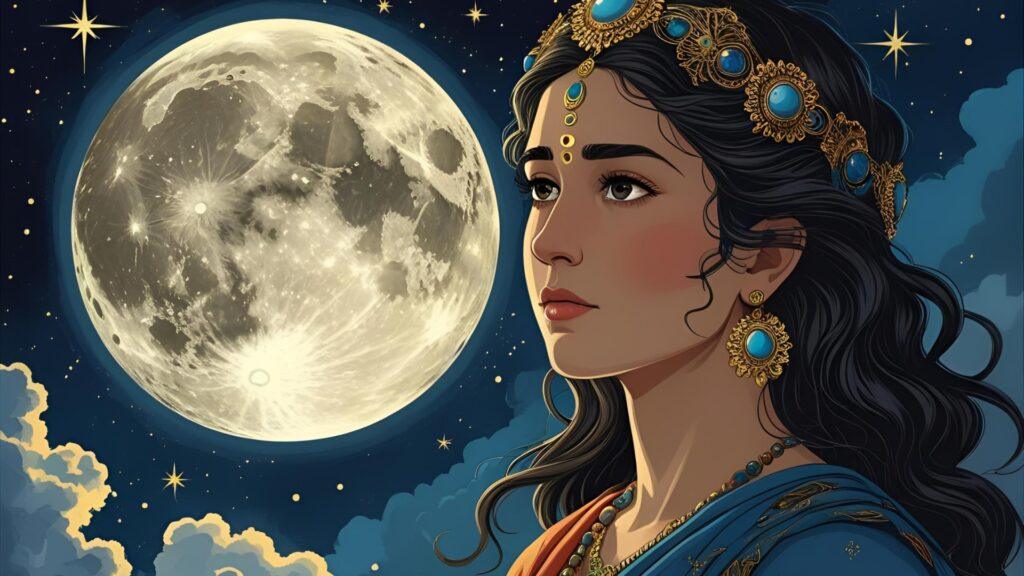
Origin: Inspired by Filipino and Polynesian sky myths
Moral: Self-worth isn’t about being the brightest
Long, long ago, when the world was still learning how to spin, the Moon shone brighter than anything in the sky.
Even brighter than the Sun.
Her name was Luna, and her light was soft but strong. It didn’t burn. It didn’t blind. It bathed the Earth in silver. Rivers shimmered. Owls flew by her guidance. Children looked up at her and whispered goodnight.
Luna loved watching the Earth sleep.
She watched animals curl up in dens. She saw grandmothers brushing hair by candlelight. She saw wolves dancing on mountaintops, howling just for her.
She glowed with happiness. And the Earth loved her back.
But one night… her glow dimmed.
Not much at first. Just a little. Like a candle flickering in the wind.
She thought she was tired.
“I’ll rest tomorrow,” Luna told herself. “Just a quick nap after sunrise.”
But the next night… it dimmed again.
And the next.
And the next.
Until one evening, when she rose into the sky, children looked up and gasped.
“She’s gone!” they cried.
Luna looked at herself reflected in a still lake far below. She was right.
She was there… but barely.
A pale shadow of who she had once been.
She tried rubbing her cheeks.
She tried spinning faster, dancing through the sky.
She tried singing to the stars to bring her light back.
Nothing worked.
Her glow was gone.
“I must have done something wrong,” Luna whispered.
But she didn’t know what.
She decided to ask the Sun.
He was loud. Golden. Always in a rush.
But maybe he knew.
When the night ended, Luna waited just a little longer in the sky—until the Sun came bounding up like a lion through the clouds.
“HELLO, LITTLE SISTER!” the Sun boomed.
“Sun,” Luna said quietly, “I’ve lost my glow. Do you know why?”
The Sun squinted at her. “Glow? Hm. Have you been eating your light berries?”
“What are those?”
“Ah. I don’t know. I just made that up.” He laughed loudly. “Ask the Wind. She knows everything.”
And off he blazed, leaving Luna feeling smaller than ever.
The next night, Luna called to the Wind.
She arrived with a whisper, curling around the trees.
“Wind,” Luna said, “why have I lost my glow?”
The Wind circled her slowly.
“You’re lonely,” she said.
“Lonely?” Luna blinked.
“You watch everything. But no one watches you.”
“But they do!” Luna cried. “The children. The wolves. The rivers.”
“Yes,” Wind said. “But when have you come down to them? When have you let them know you?”
“I… I don’t.”
“Then go,” the Wind whispered. “Go down to Earth. Find what you’ve lost.”
And just like that, the Wind blew her downward.
Luna had never touched the Earth before.
Now she stood—barefoot—in a quiet forest.
The trees were sleeping.
The stars blinked high above.
She took a step.
The grass shimmered faintly where her feet landed. Not with light. But with memory.
Everywhere she walked, the earth remembered her glow.
But she still couldn’t feel it.
She passed a fox curled in a hollow log.
She passed a tired hunter, bow across his back, sleeping beside a fire.
She passed a stream that sang to itself.
She passed a house.
Inside was a little girl.
And the girl was crying.
Luna, invisible in her human form, stepped closer.
The girl held a picture in her hand.
A picture of her grandmother.
The girl sniffled. “You promised me you’d dance in the moonlight with me. And now you’re gone.”
Luna’s breath caught.
The girl’s name was Leela.
Luna knelt beside her, though Leela couldn’t see her.
“I’m still here,” Luna whispered.
But Leela didn’t hear.
She just wiped her eyes and looked out the window.
“Oh Moon,” she whispered, “where did you go?”
Luna waited there all night.
She watched Leela sleep.
Watched her chest rise and fall.
Watched the tears dry on her cheeks.
And for the first time, Luna felt not distant.
Not above.
But close.
The next night, she returned to the sky.
Something had changed.
She looked down.
She didn’t shine fully yet.
But there—on the lake—her reflection was clearer.
A crescent.
Just a sliver.
But real.
The Wind came back and laughed softly. “See? The more you know the world, the more it remembers you.”
“But I still don’t feel whole.”
“Then keep going.”
So she did.
Each night, Luna came down to Earth in her quiet way.
She visited an old man who played violin on his porch for no one but the trees.
She sat beside a fisherman who talked to his wife, long gone, while casting lines into the sea.
She kissed the nose of a bear cub who had lost its way and led it back to its mother.
Each time, her glow returned a little more.
The stars began to hum when she passed.
The wolves started howling again.
The rivers began shimmering once more.
The world noticed.
But most of all—Luna noticed herself.
One night, many days later, Luna stood once more in the sky, fully round.
Fully glowing.
The brightest she’d ever been.
Brighter than even before she dimmed.
Because now, her light wasn’t just from herself.
It came from stories.
From laughter she’d heard in homes.
From lullabies sung in quiet corners.
From tears that fell on cheeks and promises whispered in dreams.
The next time Luna saw Leela, the girl was dancing.
All alone, under the moonlight.
She twirled with arms wide, head back.
“Grandma,” she said, “do you see me?”
And Luna wanted to answer, “Yes, we both do.”
Because beside her, just for a moment, stood the shape of an old woman made of stars.
Watching too.
Smiling.
From then on, Luna never stopped visiting Earth.
And sometimes she still fades.
Not because she’s broken.
But because she’s listening.
Because she’s down below, lighting up someone’s lonely night with nothing but her quiet company.
So the next time you look up and the Moon is gone—don’t be afraid.
She might just be sitting beside you.
Glowing quietly in the dark.
The Spider Who Spun the First Rainbow
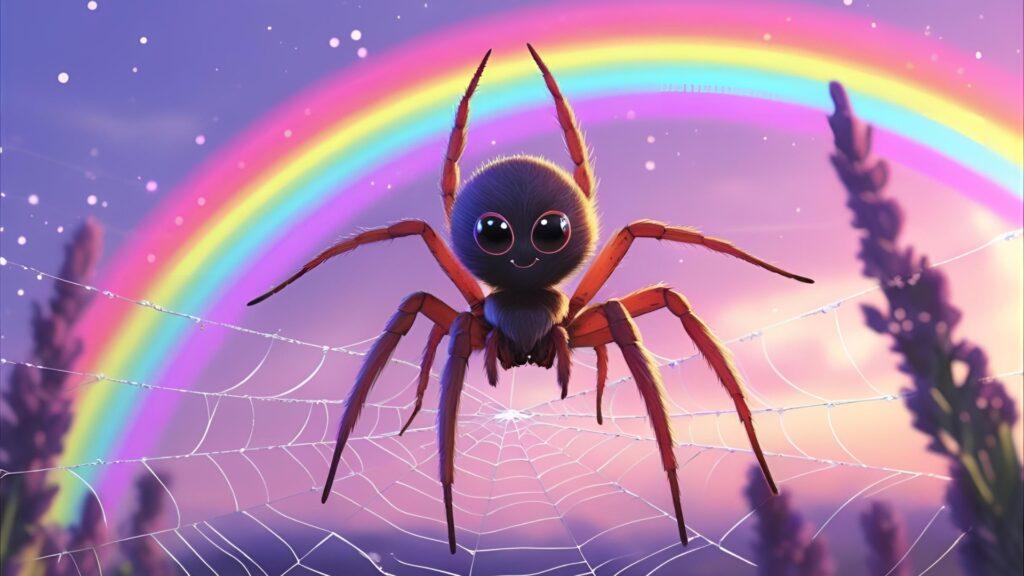
Origin: Inspired by West African and Caribbean myths
Moral: Beauty comes from collaboration
In a time when the world was still young and colors hadn’t yet learned to dance in the sky, there lived a little spider named Anu. She was not like the other animals in the forest.
While they stomped, leaped, and flew, Anu preferred the quiet corners, where dew clung to leaves and silence hummed like a gentle lullaby.
Anu loved spinning. She wove webs between trees, between rocks, even between tall grasses. They were delicate, silken patterns—some looked like the sun’s rays, others like the moon’s curve. But no one seemed to notice.
The birds chirped about how high they could fly. The elephants bragged about strength. Even the frogs, always noisy, teased Anu for being small and slow.
“Why do you waste time on those silly strings?” a parrot scoffed one day as she fluttered past. “No one looks at them, and they vanish with the wind!”
Anu didn’t reply. She just smiled a little to herself. She knew that even if no one saw her webs, the wind did. And that was enough.
But deep inside her, a wish was forming. A wish to spin something that would last. Something no wind could tear down.
One Morning After the Storm
One day, the sky split with thunder. Rain poured in sheets. It was the kind of storm that bent trees and flooded anthills. Anu huddled beneath a wide leaf, clinging to the stem, her webs torn and dangling like old threads.
When the storm passed, the forest glittered. Everything was soaked and shining, dripping like jewels. Anu stepped out, blinking at the strange, silver world.
But something felt…empty.
The sky was still crying. Not with rain, but with light. The sun had begun to peek out, weak and low, behind the retreating storm clouds.
And in that moment, the light touched the droplets in the air, and Anu saw something she’d never seen before—colors.
They shimmered just for a moment. A flicker. Red. Then gold. Then green.
And then they vanished.
Anu blinked. Had anyone else seen that?
No. The other animals were still hiding or shaking water off their fur.
She scuttled forward, heart thudding. She had an idea. A wild one.
What if she could catch that color?
What if she could weave it?
Weaving Light
For the next three days, Anu worked without rest. She climbed to the highest tree branch she could find—up past the birds’ nests, past the curious chameleon, past the buzzing bees.
At the top, the wind howled. It tugged at her thread, threatening to blow her away.
Still, she spun.
She spun in silence and spun in hope. She didn’t spin a simple web this time. No—it was different. It was long and curved like a smile. It stretched from tree to tree, high above the forest floor.
But thread alone wouldn’t bring the colors.
Anu remembered how the light had danced through the raindrops. So she gathered dew, drop by drop. She balanced them on her web—carefully, carefully, like tiny beads of hope.
Then she waited.
The First Rainbow
It happened quietly.
The sun rose again, timid after another soft shower. It peeked between the clouds and saw what Anu had made.
Light poured into the droplets, which caught it like tiny crystal bowls. And suddenly, the web was no longer just thread. It was a river of colors.
Red.
Orange.
Yellow.
Green.
Blue.
Indigo.
Violet.
A rainbow.
But this one didn’t vanish like the one after the storm. It held. It clung to her threads. It stretched across the sky like a bridge between worlds.
Below, the animals gasped.
“Look!” cried the monkey.
“What is that?” whispered the doe.
“A miracle,” the old owl said, blinking.
And high above them, Anu stood still on her thread, heart full and legs trembling.
Recognition
The other animals gathered.
They tried to climb the tree to see the web up close, but it was too high, too delicate. So they called to Anu.
“Was it you who made this?” asked the parrot, ashamed of her earlier words.
Anu nodded.
The spider who had once been called silly, slow, invisible—was now the artist of the sky.
From that day on, they never laughed at her threads again.
They called her Anu the Weaver of Light. The Keeper of Rainbows.
But the Wind Had Questions
That night, when the stars came out, the wind whispered around Anu as she rested in her curled leaf bed.
“Why did you do it?” the wind asked.
“I wanted to spin something beautiful,” Anu whispered. “Something no storm could blow away.”
The wind rustled gently, respectful now. “And you have. But rainbows fade. Will you make another?”
“If the light and drops are right,” Anu said. “Yes.”
“And if not?”
“Then I will spin a new kind of beauty.”
The Gift Spreads
What Anu didn’t know was that her rainbow had touched more than her forest.
Far beyond the trees, a child in a village looked up and saw the colors.
She gasped and ran to tell her grandmother.
The grandmother smiled. “Ah. The Spider has spun her joy.”
In another place, a fisherman paused mid-paddle, his oar frozen above the water.
A painter dropped his brush, watching the colors with tears in his eyes.
A songbird sang a tune it had never sung before.
And in each of those places, someone began to create. To paint. To write. To spin.
Anu had given them the first rainbow—but more importantly, she had given them permission.
Permission to make something beautiful, even if others didn’t see it at first.
Epilogue
To this day, when a storm passes and the sun peeks through, the rainbow appears.
Sometimes bold, sometimes faint.
But always there.
And if you listen closely, on the wind that brushes your cheek, you might hear a whisper—
“It was a spider.”
And perhaps, somewhere in a high tree, a tiny figure rests quietly, watching her colors dance one more time.
Spinning not for applause, not for fame—but simply because she can.
And because the world needs her threads of light.
Little Lava and the Volcano’s Heart

Origin: Inspired by Hawaiian and Pacific Island lore
Moral: Don’t be afraid to be different
The Rumbling Island
Long ago, in a cluster of islands surrounded by deep blue ocean, there lived a little glob of lava named Liko.
Liko was not like the fierce, roaring lava that came crashing down the mountainside. He was soft. Curious. Shiny. And often forgotten.
He lived deep inside the belly of the volcano called Kuamu, which the islanders believed had a powerful heart. Kuamu hadn’t erupted in hundreds of years, but sometimes she let out a little grumble, as if mumbling in her sleep.
The islanders would pat the ground and say, “She’s just dreaming. Don’t worry.”
But Liko worried.
He often asked the others in the lava chamber, “What’s up there? What does the sky look like? Why do we glow in the dark?”
Most other lavas didn’t care. They liked bubbling and burping and humming lava songs. But Liko was different. He felt there was more.
And deep inside, Kuamu’s heart thudded, slower each day.
A Glow That Faded
Liko noticed something the others ignored: their glow was fading.
Where once the lava pool shimmered in orange and gold, now the colors seemed dull. Like dying embers.
“Kuamu is getting tired,” Liko said to his friend, a smoky little puff called Pelea.
“She’s old,” Pelea shrugged. “Maybe she’ll go to sleep forever.”
That idea made Liko feel colder than he should ever be.
“No,” he whispered. “There has to be a way to help her.”
He looked up toward the ceiling of the cavern. There, in the cracks of stone, a thin blue light glowed. It was the color of the sky.
And something stirred in him.
Climbing Up
No lava had ever gone up before. Lava always flowed down. That was the rule.
But Liko didn’t care about rules today.
He started inching his way up Kuamu’s throat, curling around old stones, squeezing through narrow pipes, dodging sleeping magma pockets.
At one point, he slipped and almost fell into a sulfur pool.
At another, a grumpy gas spirit hissed, “Turn back! Only destruction waits above!”
But Liko didn’t stop.
His glow began to return as he got closer to the surface. Not because he was hotter—but because his heart was fuller.
The Surface
Liko peeked out of a steaming vent and gasped.
The sky was enormous. The clouds looked like floating feathers. The ocean sparkled like it was laughing. And birds—birds!—zoomed overhead, fearless and free.
Then he saw something else.
A little girl.
She was dancing alone on a black lava field with a tiny flower tucked behind her ear. She spun and twirled and fell in the grass, laughing.
Liko had never seen anything like her. He whispered to the breeze, “Who is she?”
The wind replied, “Her name is Malia. She comes to sing to Kuamu every day.”
“Why?”
“Because she believes Kuamu is still alive. Just sleeping.”
Liko’s heart bubbled with warmth.
Maybe there was still time.
Into the Heart
That night, Liko returned deep into the volcano.
He slid past grumbling rocks and resting lava, back to the heart chamber of Kuamu. It was dim now. The great heart, once a bright red orb, was flickering like a dying ember.
Liko pressed his warm body against it and whispered, “Don’t go.”
A tiny pulse answered.
Just one.
Liko remembered Malia’s dancing. Her laughter. Her hope.
And then he had an idea—wild and impossible.
But possible enough.
The Gift of Fire
Liko gathered his glow, every shimmer and spark he had. He danced around Kuamu’s heart. He spun in wild spirals. He sang a lava song, but one filled with joy.
He poured his warmth into the flickering ember.
One beat.
Two beats.
Then—a rumble.
All across the island, the ground shook. Islanders ran from their huts, pointing to Kuamu. “She wakes!”
But no lava spilled.
Instead—smoke spiraled upward like a ribbon.
And a soft light, pink and gold, poured from the crater like a sunrise trapped in a bottle.
Liko’s Choice
Inside, Liko was weak. Fading.
He had given everything.
But Kuamu’s heart was glowing again—slow and steady.
She spoke to him for the first time, her voice as deep as the earth itself. “You gave me your fire.”
“You needed it more,” Liko whispered.
“But now, you must sleep,” she said. “Unless…”
“Unless what?”
She hummed like a lullaby. “Unless you become something new.”
The Volcano Blooms
The next day, Malia climbed Kuamu’s slope. Where the lava rocks had once been sharp and bare, now flowers bloomed. Red, orange, and gold.
And in the sky—a strange cloud hovered. It was shaped like a swirl, glowing softly, watching.
“Liko,” the wind whispered, “became Kuamu’s spirit. Not lava anymore. But fire and memory.”
Malia smiled and bowed. She planted a seed on the volcano’s edge.
It grew into a small flame-colored tree.
The Legend of Little Lava
They say when a volcano sleeps, it’s not dead. Just dreaming.
They say when you see steam rising gently, it’s Liko checking on the world.
And sometimes, if you stand very still on Kuamu’s edge, you can hear the laughter of a lava spirit who once climbed up—and helped a volcano remember how to glow.
The Rabbit Who Raced the Wind
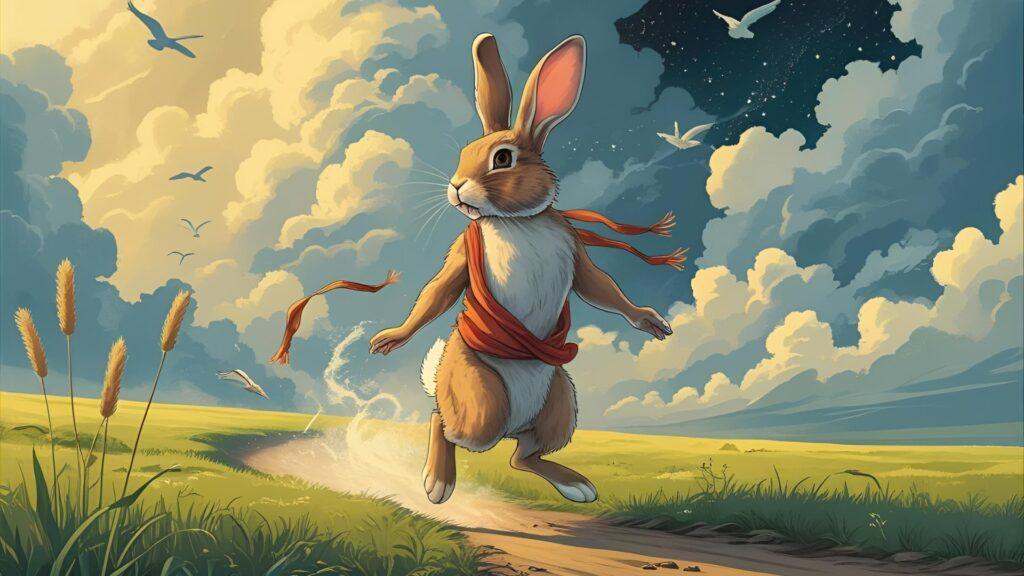
Origin: Inspired by Chinese and Japanese lunar tales
Moral: Cleverness beats speed
Once upon a time, when the world was still learning how to stretch its legs, the animals could speak the language of wind and stars. Back then, speed was not measured with clocks or stopwatches—it was felt in the heart, in the rush of paws against dirt, hooves on stone, wings slicing through sky.
And everyone knew one thing:
Wind was the fastest thing on Earth.
But not everyone was happy about that.
Especially… Rabbit.
Rabbit, whose name was Tiko, was known throughout the forest for being restless. He could never sit still. His legs bounced even when he was standing still. His whiskers twitched with impatience. While other animals were content nibbling on berries or bathing in sun patches, Tiko wanted more.
“I want to be the fastest,” Tiko would say. “Not just in the forest. Not just in the valley. I want to be faster than the Wind!”
The other animals would giggle behind their paws or feathers.
“The Wind?” Owl hooted one evening. “You mean the thing that can lift eagles and knock down trees?”
“Yes,” said Tiko. “If I can beat the Wind, I’ll be remembered forever.”
Fox, clever and always smiling, slinked over and whispered, “Then why don’t you challenge him?”
Tiko’s ears perked up. “You think I should?”
Fox nodded. “Why not? All legends begin with a little courage… and a dash of foolishness.”
That night, as moonlight spilled like milk over the glade, Tiko stood on a stump and called out:
“Wind! I challenge you to a race!”
The forest fell silent. Even the crickets stopped chirping.
Then—whoooooooosh.
A great gust stirred the leaves. Branches bowed. Flowers leaned away.
And from that rush came a voice—clear, cool, and powerful.
“You challenge me, little one?”
“I do!” said Tiko, standing tall even as the breeze lifted his ears.
“Then meet me at the edge of the world,” Wind replied, “at dawn. And bring your fastest legs.”
Then, just as suddenly, Wind was gone.
The Whispering Meadow
At first light, Tiko was already stretching. Fox came to see him off.
“You sure about this?” Fox asked. “The Wind’s never been beaten.”
“That’s why I have to try,” Tiko said, nose twitching. “Because nobody else has.”
The path to the “edge of the world” led through the Whispering Meadow—a place where the grass was so tall and soft it murmured secrets when you ran through it.
Tiko had never run this far before. The butterflies tried to distract him. The dew clung to his feet. The bees begged him to slow down. But he didn’t stop.
Not for a single breath.
When he reached the edge of the meadow, the world dropped into a wide valley that seemed to stretch forever. Mountains stood like old watchers in the distance.
Wind was already waiting.
“You came,” Wind said. “Good.”
“I always keep my word,” Tiko replied.
Wind swirled into a funnel, tall and proud. “Here are the rules,” he said. “We race from this valley to the mountaintop yonder. First to touch the oldest pine at the peak wins.”
Tiko looked up. The peak was high. Very high.
But he nodded. “Let’s race.”
“On my gust,” said Wind.
The air stilled.
Then—whoooooooooosh!
They were off.
The Race Begins
Tiko’s feet thudded against the earth.
Wind blew past trees and swirled over rocks.
Tiko zigzagged through thorns and leapt over logs. He used the rhythm of the land like a drumbeat. He was fast. So fast, the birds gasped.
Wind was faster. He darted ahead, spun through treetops, and teased Tiko with cool gusts to slow him down.
But Tiko kept running.
His legs ached. His lungs burned.
He didn’t stop.
Halfway up the mountain, he stumbled into a dark forest. The canopy above blocked the sun. Roots tangled the ground. It was Wind’s playground. He howled through the trees, making them creak and moan.
“You can turn back, Rabbit,” Wind said, echoing in the branches.
But Tiko gritted his teeth.
“No.”
A root caught his paw. He tumbled, rolling downhill until he hit a mossy patch. For a moment, the world spun. He could’ve given up. But then—
He remembered the looks in the animals’ eyes. The giggles. The doubt.
And he remembered Fox’s voice: All legends begin with a little courage.
Tiko stood up.
He ran.
The Steepest Climb
As he neared the mountaintop, the air grew thin. Snow dusted the ground. The rocks were sharp and cold. Wind danced ahead, sending flurries into Tiko’s eyes.
“I warned you,” Wind called out. “You can’t beat something you can’t hold!”
Tiko’s muscles begged for rest. His ears drooped.
But then—
He heard something.
Not Wind.
Not birds.
But the soft rhythm of his own heartbeat.
Thump. Thump. Thump.
It reminded him of his mother’s lullaby. Of the first time he’d raced his shadow. Of the joy in moving just because he could.
That beat gave him strength.
One foot. Then another. Then another.
And then…
He saw it.
The oldest pine.
It stood crooked and proud, bark twisted with time, needles whispering secrets to the sky.
Wind was already circling it, victorious.
But Tiko didn’t stop.
He sprinted.
Faster than he had ever moved.
And just as Wind swept down to rest—
Tiko leapt.
Not just a hop.
A launch.
His paw hit the bark a split-second before Wind touched it.
Silence.
Then…
The mountain sighed. The trees stilled. Even Wind quieted.
“You…” Wind began. “You beat me?”
Tiko landed, panting, legs trembling. “Only this once,” he said. “Only by a whisker.”
Then Wind did something unexpected.
He laughed.
Not a cruel laugh. A true, thunderous laugh that echoed across the valley.
“I’ve raced clouds,” Wind said. “I’ve raced storms and falling stars. But never… a rabbit.”
He swirled around Tiko like a cool hug. “You have earned something better than speed.”
“What’s that?” Tiko asked.
“Respect.”
The Legacy
From that day on, the story of Tiko the Rabbit was told in every burrow and den. His race became legend.
The wind still blows through the forest, fast and free—but when it passes the oldest pine on the mountain, it pauses. Just for a second.
Out of respect.
And sometimes, if you listen closely, you’ll hear Wind whisper to the grass:
“Faster than a rabbit? Only barely.”
And young rabbits, feeling bold, will smile and say:
“Then maybe… I’ll race too.”
Because that’s how legends are born.
Not from winning.
But from daring to try.
Why Kids Still Love Myths (Yes, Even in the TikTok Era)
You’d think kids wouldn’t care about gods who fly or animals who talk. But they do. Deeply.
Because myth taps into the same part of the brain that builds forts from blankets and gives names to stuffed animals. It’s primal. It’s powerful. And best of all? It doesn’t need perfection.
These tales work because they don’t always make logical sense. But they make emotional sense. They answer the big “why” questions — why the sun sets, why we feel jealous, why kindness matters — with images, not charts.
When kids hear these myths, they don’t just learn about culture or characters. They learn about themselves. About being brave. About making mistakes. About what it means to be human.
My First Myth Came With Mangoes and Mosquitoes
Let me tell you something personal.
I grew up in South India. One summer afternoon, I sat at my grandmother’s feet, fanning myself while nibbling sticky mango slices. I was maybe seven or eight. Restless. Bored.
That’s when she told me about Hanuman — the monkey god who leapt across oceans to save someone he loved.
He could grow as big as a mountain or shrink to the size of a mouse. He wasn’t the strongest or the smartest, but he was loyal. Fiercely loyal.
I was hooked.
No special effects. No flashy animations. Just her voice, rising and falling like a drumbeat. That story lived inside me for years. Still does. Because it didn’t just entertain me. It told me I could be small and still powerful. Scared and still brave.
And that’s what myth does. It sneaks lessons into your soul, like sugar in medicine.
What Makes a Mythology Story “Kid-Friendly”?
Let’s be real. Some myths are intense. Betrayal. Monsters. Weird relationships. You don’t want to drop full-on Greek tragedy into bedtime story hour.
But when chosen carefully, myth stories can be the perfect mix of fun, wonder, and wisdom.
Here’s what to look for:
- Short and simple plots that can be told in 5 to 10 minutes
- Magical elements — animals talking, gods transforming, impossible things happening
- Characters with clear goals, strengths, and flaws
- A lesson, but not a lecture
- Humor or trickery (kids love a clever underdog)
Remember, myths weren’t always told to teach. They were told to entertain. The lesson just happened to tag along.
Storytelling Tips for Grown-Ups
If you want kids to fall in love with mythology, don’t just read the stories. Perform them.
Seriously. Act them out. Use silly voices. Make sound effects. Pause dramatically at cliffhangers. Let kids shout out guesses about what happens next.
The best stories aren’t told at kids. They’re shared with them.
Make It Interactive
Ask questions during the story. Let their imagination jump in:
“What would you do if you were Anansi?”
“Can you draw your own moon rabbit?”
“Why do you think Thor agreed to wear the wedding dress?”
These open-ended questions spark deeper thinking — and giggles too.
Bring the Story Into Their World
Help them connect myth with everyday life. Make it feel like the story could happen right now:
“Hanuman would totally jump from your school roof to the grocery store.”
“Anansi? He’d be a YouTuber pulling pranks for wisdom.”
When kids see themselves in the story, they don’t just listen. They live it.
It’s Not About Being Perfect
Forget fancy words or flawless delivery. Myths were never meant to be perfect. They were meant to breathe. To evolve with each voice that tells them.
So stumble. Giggle. Exaggerate. Make it fun. Make it yours.
Because in the end, kids don’t remember polished. They remember passion.
And that’s what makes a story stick.
Final Thought: Let the Stories Live
Still not sure if mythology matters today?
Let me leave you with this.
One evening, after telling the story of Ganesha — who broke his own tusk to finish writing a sacred text — I found my niece in her room with a broken crayon.
“I’m like Ganesha,” she said. “I broke my crayon but finished my drawing.”
That’s mythology working its quiet magic.
It’s not just about gods and monsters. It’s about meaning. And giving kids a way to make sense of their own messy, beautiful, growing-up lives.
So please, tell the stories.
Not because they’re old. But because they still feel new.
Because somewhere in a child’s mind, a monkey is flying, a rabbit is leaping, and a spider is laughing.
And that? That’s how wonder survives.
FAQs: Mythology Stories for Kids
Q: Are mythology stories too intense for children?
Not if you choose wisely. Many myths were made for oral storytelling, which means they’re adaptable. Tweak them, soften them, and focus on heart over horror.
Q: How long should these stories be?
Aim for 5–10 minutes. That’s enough time to tell the story, add a lesson, and spark a conversation. Perfect for bedtime or story circles.
Q: Can I make up parts I forget?
Absolutely. Myth is meant to evolve. Every storyteller adds their flavor. That’s how these tales have survived for thousands of years.
Q: Do kids actually remember these stories?
Oh yes. In the same way they remember their favorite cartoons. Except these stories come with deeper meaning and lifelong takeaways.
Mark Richards is the creative mind behind Classica FM, a podcast platform that brings stories, knowledge, and inspiration to listeners of all ages. With a passion for storytelling and a love for diverse topics, he curates engaging content—from kids’ tales to thought-provoking discussions for young adults.



